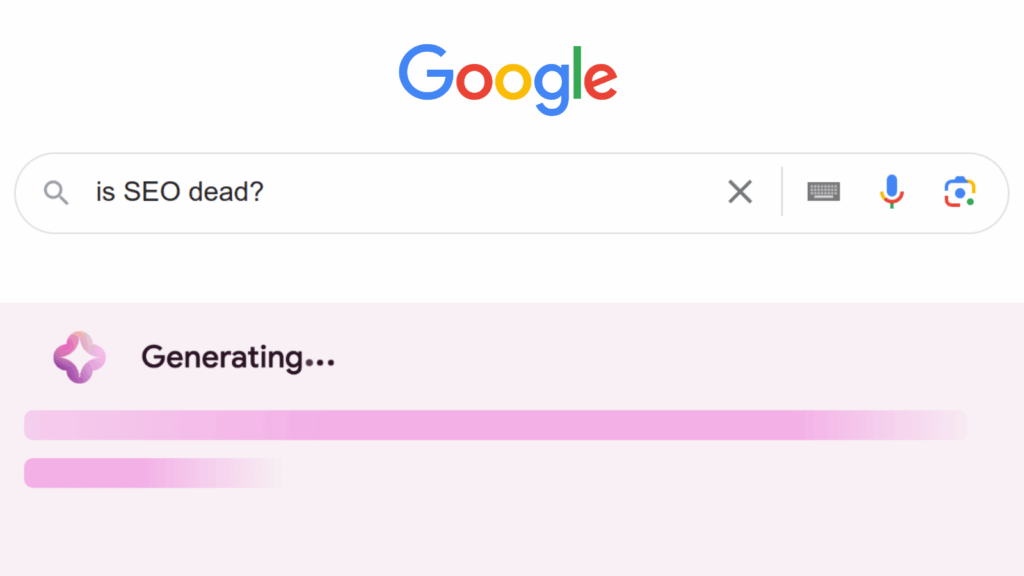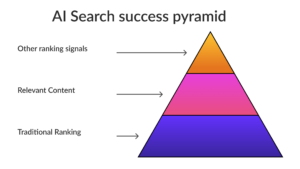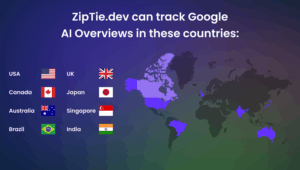Google has massively changed the publishing landscape over recent months, due to AI Overviews.
Let’s take the example of the query: “best bedtime snacks”.
In the past, Google users would likely click on the first result, which is an article on Healthline.com, read or skim it, then some of them would click on ads, in this case: gummies for better sleep.
Occasionally, they would click other pages ranking in the top 10, but the idea is the same: they visit pages proposed by Google, and then they consume the content. Finally, they click the ads. Publishers earn revenue either through ads, or subscriptions (paywalls).
Now AI Overviews change everything. An AI summary appears on top of the results for multiple queries.
Let me show some examples:
Example 1: “celery juice benefits”
Example 2: best bedtime snacks
Example 3: can you shower in a thunderstorm:
This clearly changes the whole ecosystem, affecting which brands make it to the top of Google Search results and how publishers make money from online content.
Some SEOs compare this revolution to Featured snippets. In my opinion, AI Overviews will have a MUCH bigger impact than Featured snippets.
And, since Google AI Overviews usually show 3-6 sources, it’s much easier to get in the list of sources and, as a result, increase your SEO visibility.
Why you should care
AI Overviews is a massive change in Google search results.
First and foremost, AI Overviews take the top spot, rendering traditional search results less prominent.
I illustrate this on the diagram below:
As it’s the top spot, getting the most attention of Google users, you should try to find a way to make your brand appear in AI Overviews.
Currently, according to our benchmark, AI Overviews appear on 18% of queries related to publishers:
Just in June 2024, it was less than half.
Here are three main challenges for publishers associated with AI Overviews:
- Impact on Clicks and Revenue: AI Overviews occupy the top spot, possibly fulfilling user intent. This can lead to fewer clicks and thus, potentially lower revenue
Let’s take “celery juice benefits” as an example (covered by WebMD and MedicalNewsToday).
Users typing this query get quite a comprehensive answer from AI Overview.
Honestly I feel there is no need for them to click on any of the sources.
- New competitors. New algo shifts from content to answers effectively promote new players in search results. According to my research, as much as 63% of sources don’t rank in the top 10.
- Overlooked by most SEOs and marketers: shift from keywords to conversations. It’s more like the experience you know from chatGPT.
Thanks to AI Overviews, Google users can query Google using natural language.
This was not possible through the first 20 years of search engines, as users were forced to be limited to keywords.
Now I can tell Google: “I have a Samsung Galaxy S20. I’m looking for a new phone up to 1000 USD with a good camera, I’m interested mostly in landscape photography and good battery life”.
A disclaimer, I’m not an Apple fanboy, it’s just a simulation 🙂 I don’t own a Samsung s20 either.
I believe the Google search will become conversational over time. We will see if and when this behavior shift happen.
Regardless of whether or not this behavior shift happens, it’s clear that AI Overviews and other AI search interfaces (such as chatGPT) are effective for users and are becoming widely adopted (over 100 countries and territories now).
In the EU, regulation is holding back the release of AI Overviews, but this won’t be forever.
This means you will continue to see AI Overviews results across most markets including ones associated with your brand.
You cannot escape this change, but you can take steps to make sure AI Overviews works for you and your business.
4 observations related to AI Overviews
After analyzing thousands of AI Overviews, from the publishing space, as well as other niches, let me share four observations that I believe will help you understand it better, and (ideally) be included in AI Overviews and will limit time spent on trial and error.
Observation #1: Google AI Overviews ranking is different from “traditional” SEO
According to my research, as much as 63% of sources don’t come from the top 10 traditional search results.
This means that the algorithm for AI Overviews is different from “traditional” search results.
To understand this better, let’s use a simplified model.
In traditional ranking, Google’s job is to send you to pages that you will likely be satisfied with.
With AI Overviews the goal is different, it’s about showing you the best answer.
Let’s use an example.
Type in Google: “Best smartphone 2024”.
You will see websites giving you a full overview of phones classified by reviewers as the best one.
For instance, a website ranked #1, ZDNet, gives us the following:
- a handy ranking of phones,
- detailed description of each tested phone, with links to comprehensive reviews (I didn’t check if they are biased though!),
- additional information about choosing Android vs iOS and then, a comprehensive FAQ.
When Google users type “best smartphones in 2024” AI Overviews, like a good salesman, gives you a brochure: “here is list of best phones, buy one of them”).
This is effectively a shift from ranking best content to finding best content fragments.
This clearly implies different ranking signals.
You will find tons of articles and posts covering how to rank in AI Overviews.
Most of them focus on generic stuff.
What I recommend doing is to check a sample of keywords that generate AI Overviews and try to analyze what made Google choose a specific source.
In ZipTie.dev you can easily select a list of keywords generating AI Overviews.
Observation #2: You can leverage YouTube to increase chances of getting featured in AI Overviews
I noticed that sometimes Google can pick YouTube as a source.
For instance, for the query: “celery juice benefits” one of the sources AI Overviews has chosen is a Youtube video.
As many publishers have Youtube channels, they can leverage them to increase their visibility in AI Overviews.
From a technical point of view, for now, it’s not clear to me if Google takes it from the video description on Youtube or from transcription. Taking it from a video description would be much easier for Google. If your Youtube videos aren’t picked up as a source, I would consider adding useful description and see if this makes a difference.
If you are not sure how to check if Google picks up Youtube videos as a source, you can use filters in ZipTie, and select: List of sources contains Youtube.com.
Observation #3: you don’t have to have topical authority to rank in AI Overviews
I didn’t undertake huge studies checking the influence of topical authority for AI Overview presence.
However, I’ve seen many instances of huge brands with no particular topical authority, taking the top places, both in Google traditional results and AI Overviews.
For instance, ZDNet ranks for best smartphones 2024 in both traditional search results and AI Overviews.
When I type: “what is the best beard trimmer in 2024? I am looking for trimmers up to 100 usd” I can see AI Overviews uses sources such as The New York Times, New York Magazine which are trusted sources, but clearly don’t have topical authority in beard trimmers, or even with testing electronics.
Another example: for the query: “what are the 10 benefits of celery juice” one of the sources selected is The Times of India
Another example: “How to check my IP”, one of the sources chosen by Google is… UNC School of Medicine. This topic is TOTALLY unrelated to medicine.
Yet another example: a query: “who is Kim Kardashian dating”:
You can see that one of the sources Google chose was… Business Insider, which clearly has no topical authority within the celebrities & gossip space.
So it seems that having topical authority is not a requirement.
Disclaimer 1:
Obviously, the brands I mentioned have strong brands, so Google may show them despite having no topical authority.
Disclaimer 2:
Obviously, this may change in the future. What you can do is observe trends over time. We have a dedicated landing page for this. It’s available here.
Observation #4 – query selection has an EXTREME effect on the AI Overviews share
This observation is extremely important for people who want to understand the real impact of AI Overviews.
We released a public benchmark that we regularly refresh and we clearly see that AI Overviews are extremely dependent on the sample of keywords. https://dashboard.ziptie.dev/aio-monitor
On top of verticals, such as Publishers, Finance, Health, etc, we have some more detailed horizontal sections.
For instance, keywords related to reviews show AI Overviews in just 9% of cases (still 10x more than in July!)
On the other hand, queries related to “how much” are shown for almost 54% of queries.
As an example, I dove deeper into Forbes, and the results are pretty interesting.
| Query selection samples | % of queries generating AI Overviews |
| Top queries having featured snippets | 63% |
| Top queries with minimum 3 words | 14% |
| Top queries with minimum 5 words | 39% |
| Top queries | 8.8% |
| Questions – “what is” | 39% |
This table gives us very useful information you can use in your strategy of AI Overviews preparation. So it’s clear that query selection has an EXTREME effect on the AI Overviews share.
For instance, you may go with this counter-intuitive idea: not caring that much about top of the funnel keywords as they are unlikely to generate AI Overviews.
Instead, you can focus on informational content (as you can see questions containing “What is” generate AI Overviews in 39%).
Obviously treat this as an idea, not a ready-made strategy.
Obviously, AI Overviews are still experimental and the share of AI Overviews may change dramatically.
To stay on top of the changes, you can use ZipTie.dev.
It’s pretty straightforward. Just paste a list of keywords you want to check and voila’!
You can even set up monitoring to see changes over time.
Heads up: challenges for measuring impact of AI Overviews.
Let’s imagine you publish evergreen articles and they are already bringing you traffic.
The hypothetical list includes:
- Best phones in 2024
- Best beard trimmer in 2024
- 10 benefits of celery juice
Then you will see that they generate 0 AI Overviews. You report to your bosses / CMOs, or note that AI Overviews don’t appear for these queries.
This could be wrong.
What I noticed is that AI Overviews are not consistent.
Commonly, even if you don’t see an AI Overview, when you slightly change the wording, you will get AI Overviews.
First example:
“What is best beard trimmer in 2024” is not showing an AI Overview in Google.
But when I slightly change it to:
“what is best beard trimmer in 2024? I am looking for trimmers up to 100 usd” I can see AI Overviews
I can see that Google picks three sources: Wired, The New York Times and New York Magazine.
Second example:
When I type, “10 benefits of celery juice” I get no AI Overviews.
But when I slightly change it to:
“what are the 10 benefits of celery juice” or
“benefits of celery juice “
I get AI Overviews.
My take:
At the moment Google may not show AI Overviews for top of the funnel keywords.
It’s more likely to be shown when it’s clear you’re looking for more information.
It’s not clear if it’s by design, or Google doesn’t want to lose too much money.
Anyways, I believe over time it will become more stable and measuring the impact of AI Overviews will be easier.
Opinion: the biggest factors affecting share of AI Overviews
Google will increase the share of AI Overviews over time. Now it seems to me Google is limited by two factors:
- Google is not putting ads in AI Overviews, except for very limited usage. Once they will find a good way to earn money, they will likely increase the share of AI Overviews.
- Satisfaction rate. Google just can’t put AI Overviews for every keyword. This would translate to extremely low satisfaction rates. I think that, instead, they need to measure how people react with AI Overviews, and ideally, show AI Overviews for selected keywords.
Ways to stay ahead of the game
We see Google’s statements that the links included in AI Overviews get more clicks than if the page had appeared as a traditional web listing for that query.
My opinion:
We can’t verify the methodology of Google’s measurements. It’s not clear is it the average from websites ranking top 3? Top 10? Or top 50?
But AI Overviews will likely mean fewer clicks, at least for top keywords. I would love to be wrong but I try to be as objective as possible.
However, there are a few points that can increase your brand’s success.
- If you don’t rank top 10, by optimizing for AI Overviews you can effectively go to top search results (this way you effectively bypass the top 10). This can translate into more clicks to your website.
- AI Overviews is not only a click game, but also a branding and PR one. According to the basic theories of influence by Robert Cialdini, when Google AI Overviews refer to you as a source, in people’s minds your brand can become a trusted source.
It’s clear that the publishing space is one of the industries with the highest share of AI Overviews.
Obviously, AI Overviews (considering their prominent position on top of the results) becomes position 1, catching the most user attention.
To stay on top, I recommend tracking how prominently you show in AI Overviews and trying to optimize your content for AI Overviews.
Don’t treat AI Overviews only as a danger (yes, it is a danger!), but also as a way to increase the visibility of your brand in Google.
For instance, considering that 63% of AI sources don’t come from top 10 traditional search results, it opens room for new possibilities. As AI Overviews appear on top, it could be your way to be on top of search results even if you don’t rank top 10.
A huge thank you to Jes Scholz and Jakub Sawa for their valuable feedback on this article. Your insights from the news SEO world really helped make it better!
FAQ – wrapping up
What are AI Overviews and how do they appear in search results?
AI Overviews are AI-generated summaries that appear at the top of Google search results, synthesizing information from multiple sources to provide comprehensive answers to user queries.
How do AI Overviews affect website traffic and revenue?
AI Overviews may reduce click-through rates since they provide answers directly in search results, potentially decreasing traditional ad revenue. However, being featured as a source can increase brand visibility and authority.
How does AI Overview ranking differ from traditional SEO?
Unlike traditional SEO, AI Overviews focus on finding the best content fragments rather than entire pages. Sources can come from outside the top 10 search results, suggesting different ranking signals are at play.
Do you need topical authority to appear in AI Overviews?
Yes. It’s very rare to see that websites with low topical authority can be featured in AI Overviews.
What role does YouTube content play in AI Overviews?
YouTube videos can be selected as sources in AI Overviews, providing an additional opportunity for visibility through video content and descriptions.
How consistent are AI Overviews across different search queries?
AI Overview appearance varies significantly depending on query type. Informational queries and questions (especially “what is” formats) tend to generate more AI Overviews than top-of-funnel keywords.
What can publishers do to optimize for AI Overviews?
Focus on creating clear, informative content, leverage multiple formats including video, and monitor which query types generate AI Overviews in your niche.
How might AI Overviews evolve in the future?
Google is likely to increase AI Overview prevalence once they develop effective monetization strategies and achieve satisfactory user experience rates.






